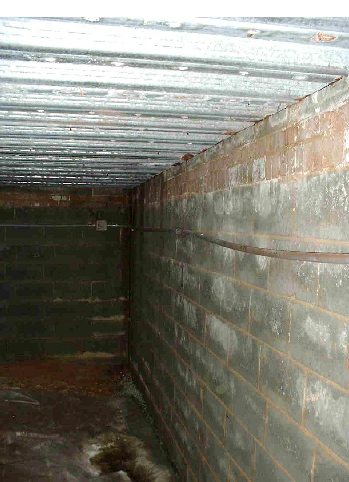Water vapor is lighter than air and the water vapor molecule is smaller than air’s other molecules—nitrogen and oxygen. Therefore, water vapor can rise faster and squeeze through smaller microscopic spaces than air. When water vapor moves through a solid material, this is called vapor diffusion.
 Materials vary in their permeability to water vapor. Porous materials like brick and insulation transmit water vapor relatively rapidly and are said to have a high permeability. Plywood and drywall have a medium permeability. Metals and plastic films, often called vapor barriers, slow vapor diffusion to a trickle.
Materials vary in their permeability to water vapor. Porous materials like brick and insulation transmit water vapor relatively rapidly and are said to have a high permeability. Plywood and drywall have a medium permeability. Metals and plastic films, often called vapor barriers, slow vapor diffusion to a trickle.
A force called vapor pressure drives vapor diffusion. Vapor pressure is created by a difference in the amount of water vapor in two bodies of air, which are separated by some barrier, like a wall. The amount of water vapor in the air—called absolute humidity or humidity ratio—is expressed in pounds of water vapor per pound of dry air. Vapor pressure is the difference in absolute humidity between two air masses. The greater the vapor pressure, the faster water vapor flows through building materials separating the two air masses.
Relative humidity (rh)—the percentage of the maximum moisture that air at a given temperature can hold—is 100% when the air is saturated with moisture. Add more moisture to saturated air, and liquid droplets form fog, then moisture condenses on cool objects. Relative humidity is 50% when the air at a particular temperature is only half saturated with water vapor. Building materials’ moisture content is directly related to the relative humidity of the air surrounding them. High relative humidity in indoor air can cause comfort problems in summer, and condensation problems in both summer and winter. Experts on cooling say the air should be less than 60% relative humidity for adequate indoor comfort in summer. Experts on winter conditions say that indoor relative humidity in cold climates should be less than 40% to avoid moisture condensation problems.
Residential Energy: Cost Savings and Comfort for Existing Buildings, Saturn Energy Auditor Field Guide, and Your Mobile Home: Energy and Repair Guide for Manufactured Housing contain more information about solving moisture problems.
